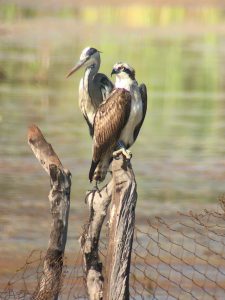Looking ahead to the 2020 Osprey Season
2020 promises to be an exciting year for the Ospreys in Poole Harbour, marking the fourth season of the Translocation Project.
Now over halfway through the project, we will start to see the impact of our hard work, and hopefully be closer to our aim of restoring a breeding population of Ospreys to the South Coast.
We’ve got another busy translocation season ahead and will be releasing a new cohort of juvenile Ospreys from Scotland, with up to 12  individuals. Over Christmas, we received fantastic news affirming the success of our 2019 season, which was a sighting of recently released juvenile 019 in The Gambia. This sighting was reported by Joanna Dailey who sent us some beautiful photos of 019 looking healthy and in her element at Gunjur Quarry, some 3,500 miles away (see photo). She’s now been seen there on two occasions, most recently on the 19th of January, reported by the team from the Osprey Leadership Foundation. The translocation work will start again in the summer, but before then we will have plenty to be getting on with…
individuals. Over Christmas, we received fantastic news affirming the success of our 2019 season, which was a sighting of recently released juvenile 019 in The Gambia. This sighting was reported by Joanna Dailey who sent us some beautiful photos of 019 looking healthy and in her element at Gunjur Quarry, some 3,500 miles away (see photo). She’s now been seen there on two occasions, most recently on the 19th of January, reported by the team from the Osprey Leadership Foundation. The translocation work will start again in the summer, but before then we will have plenty to be getting on with…
We’ve been working hard over the winter to plan for this season and to fundraise for our project developments, including the much-anticipated Osprey nest webcam! Last year, the project saw the first signs of success when 2-year-old translocated male, LS7, returned to the harbour in June. By a stroke of fate, he met a Rutland-born female, CJ7, who has been summering in the harbour since 2017, and the pair quickly began bonding and nest-building on platforms around the harbour. The response to this story and to our fundraising campaign has been incredible, meaning that we will be able to stream live Osprey updates online, should we be so lucky as to have nesting birds. Although nothing can be guaranteed this season, including both of their return, we have our suspicions of their preferred nesting site, and so will be installing the webcam on that nest over the next month or so. We are hosting another fundraising cruise, sponsored by Osprey Europe, on the 10th of May for the campaign, so come join us during the Osprey season as we explore the harbour.
Adding to the anticipation for the Osprey season, is the increased likelihood of returnee adults. Last summer, we saw LS7 and CJ7 pair-bonding in the harbour, but this year they could be joined by others. Ospreys will typically first return to the UK aged between 2-3 years, which means we could see new individuals both from year 1 and 2 of the translocation project. We also may see individuals like Beaky, a female who has spent a lot of time in the harbour last year during spring and autumn, return and potentially summer in the area.
For now, we can sit tight and wait for the next 2 months to pass, keeping our fingers crossed for another successful season!
You might also like...
Harbour Update – posted 22/11/24
Bitterly cold again today with more evidence of movement/arrivals with 4 Goldeneye in the harbour (2 south shore…
Find out moreHarbour Update – posted 21/11/24
With heavy rain forecast for today, it was a bit of a surprise when we ended up with…
Find out moreCall 01202 641 003
© 2024 Birds of Poole Harbour Registered Charity No. 1152615
